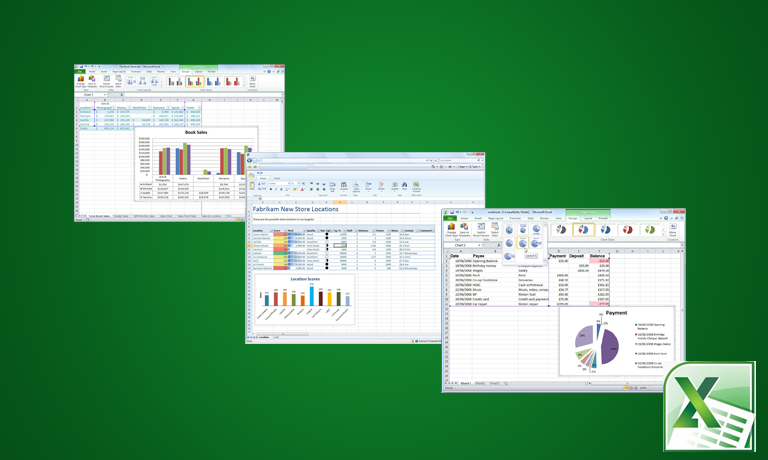Discovering the Power of Excel 2010-2013 PowerPivot Data Analytic Expressions (DAX)
Instructors
Discovering the Power of Excel 2010-2013 PowerPivot Data Analytic Expressions (DAX)
Prerequisites
Experience with Excel and Microsoft SQL query writing is helpful.
About This Course
This course is intended to expose the students to the technology of DAX and to familiarize them with functionality of DAX at an advanced level to produce sophisticated DAX calculations by use of the functions of DAX. This course is based on Excel Professional 2013 or higher.
Audience Profile
This course is intended for Power Users, Business Intelligence Developers, and IT Professionals that will be involved with the development of Excel PowerPivot queries and tabular modeling.
At Course Completion
- Explain and utilize DAX syntax.
- Explain and utilize DAX data types and operator overloading.
- Explain and utilize DAX operators.
- Explain and utilize DAX values.
- Understand and utilize PowerPivot Data Model.
- Explain error handling.
- Explain and utilize mathematical functions.
- Explain and utilize statistical functions.
- Explain and utilize logical functions.
- Explain and utilize information functions.
- Explain and utilize text functions.
- Explain and utilize conversion functions.
- Explain and utilize aggregation functions.
- Explain and utilize relational functions.
- Explain and utilize the CALCULATE function.
- Explain and utilize filter functions.
- Explain and utilize single table evaluation context.
- Explain and utilize multiple table evaluation context.
- Create and configure calculated fields.
- Create and configure calculated columns.
- Explain and utilize date functions.
- Explain and utilize working with calendars.
- Explain and utilize using multiple calendars.
- Create and configure date calculations.
- Explain and utilize many-to-many relationships.
- Explain and utilize banding.
- Explain and utilize EVALUATE.
- Explain and utilize advanced DAX capabilities.
- Explain the benefits of DAX Studio.
Module 1: Course Overview
This module explains how the class will be structured and introduces course materials and additional administrative information.
Lessons
- Introduction
- Course Materials
- Facilities
- Prerequisites
- What We’ll Be Discussing
Lab 1: Course Overview
- None
After completing this module, students will be able to:
- Successfully log into their virtual machine.
- Have a full understanding of what the course intends to cover.
Module 2: Introduction to DAX
In this module we will introduce DAX and explain the syntax. We will then explore the different parts that make up a DAX formula, demonstrate how they work, and cover errors that you may encounter along the way. This module aims to get you started with the basics.
Lessons
- Introduction to DAX
- Explaining Syntax
- Exploring Data Types
- Utilizing Operators
- Understanding Values
- PowerPivot Data Model
- Handling Errors
Lab 1: Introduction to DAX
- DAX Syntax
- DAX Data Types and Operator Overloading
- DAX Operators
- DAX Values
After completing this module, students will be able to:
- Explain and utilize DAX syntax.
- Explain and utilize DAX data types and operator overloading.
- Explain and utilize DAX operators.
- Explain and utilize DAX values.
- Understand and utilize PowerPivot Data Model.
- Explain error handling.
Module 3: Using DAX Functions
In this module we will cover DAX functions and their abilities. We will demonstrate their capabilities as well as show you how to utilize them.
Lessons
- Mathematical Functions
- Statistical Functions
- Logical Functions
- Information Functions
- Text Functions
- Conversion Functions
- Aggregation Functions
- Relational Functions
Lab 1: Using DAX Functions
- Mathematical Functions
- Logical Functions
- Conversion Functions
- Aggregation Functions
- Relational Functions
After completing this module, students will be able to:
- Explain and utilize mathematical functions.
- Explain and utilize statistical functions.
- Explain and utilize logical functions.
- Explain and utilize information functions.
- Explain and utilize text functions.
- Explain and utilize conversion functions.
- Explain and utilize aggregation functions.
- Explain and utilize relational functions.
Module 4: Understanding Evaluation Contexts
This module aims to clarify more advanced DAX concepts, which require an understanding of evaluation contexts.
Lessons
- The CALCULATE Function
- Filter Functions
- Single Table Evaluation Context
- Multiple Table Evaluation Context
Lab 1: Understanding Evaluation Contexts
- Calculated Fields
- Calculated Columns
- Evaluation Contexts
After completing this module, students will be able to:
- Explain and utilize the CALCULATE function.
- Explain and utilize filter functions.
- Explain and utilize single table evaluation context.
- Explain and utilize multiple table evaluation context.
- Create and configure calculated fields.
- Create and configure calculated columns.
Module 5: Working with Dates
In this module we will explore how to work with dates and utilize Time Intelligence.
Lessons
- Date Functions
- Working with Calendars
- Using Multiple Calendars
Lab 1: Working with Dates
- Date Calculations
After completing this module, students will be able to:
- Explain and utilize date functions.
- Explain and utilize working with calendars.
- Explain and utilize using multiple calendars.
- Create and configure date calculations.
Module 6: Utilizing Advanced DAX Functionality
In this module we will cover many-to-many relationships and demonstrate their use along with exploring banding and DAX query capabilities.
Lessons
- Many-to-Many Relationships
- Banding
- EVALUATE
- Simplifying Your Life with DAX Studio
Lab 1: Utilizing Advanced DAX Functionality
- Advanced DAX
After completing this module, students will be able to:
- Explain and utilize many-to-many relationships.
- Explain and utilize banding.
- Explain and utilize EVALUATE.
- Explain and utilize advanced DAX capabilities.
- Explain the benefits of DAX Studio.
Course Reviews
No Reviews found for this course.

